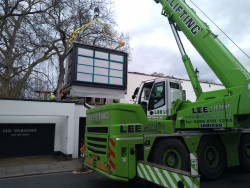64 Old Church Street is a Grade II* listed residence, designed
by Erich Mendelsohn and Serge Chermayeff in 1936. It has been a home and focus
for the family of its current owner for more than 40 years. During this time,
the building has demonstrated its flexibility, adapting to accommodate the
changing circumstances and needs of its occupants through a series of sensitive
adjustments to the internal configuration of space that retain the essential
spirit and character of the building. In 1992, Sir Norman Foster and Partners
were commissioned to design a new conservatory at the south end of the building,
sympathetic in nature but clearly defined as a contemporary addition.
A new prefabricated extension at the north end of the
building on the first floor provides self-contained living accommodation, with
the conception of offsite fabrication designed to minimise disruption to the existing
house and its occupants. It also enables the existing house to be reinstated to
its original state in the future if desired.
The new intervention complements the existing building by
following the tripartite vertical division and proportions of the glazing,
whilst carefully maintaining the building’s asymmetry and clear segregation between
old and new. Internally, careful research into the materials used and the
replication of key details ensures that the space is a seamless continuation of
the original house.
Working with structural engineers Expedition Engineering and
fabricators Weber Industries, Apt designed the open plan space to have three
distinct zones: kitchen, dining, and living, under a series of vaulted
ceilings. This led to the design of three structural steel frames and in turn,
three individual modular pods which were manufactured offsite, and then
assembled on-site to form a singular extension. “A modular system might not be
the first solution that comes to mind for an extension to a listed property,”
said Alessandro Maccioni from Expedition Engineering. “However, the bespoke
system that we developed with Weber Industries and the rest of the design team
ensured the highest quality of finish and limited significant site works to a
single day.”
The evolution of the design enabled the pods to be
constructed offsite and arrive largely complete, with insulation, cladding,
roofing, dry lining, building services and fixed joinery assembled within the workshop.
The remote development of the modules provided opportunity for regular
inspection and sign-off of details, both in terms of aesthetics and construction
methodology, reducing the need for onsite adjustment.
The installation of the pods was meticulously planned over
several months, including the commissioning of a point cloud survey which would
serve to assist the extension’s integration with the listed building fabric. An
independent structural frame spanning between the garage wall and the existing
house provides the platform upon which the pods sit, meaning all preparatory
work could be completed in advance without major disruption. The three units
were delivered to site and lifted by crane over an eight-hour period, before
being bolted into position and sealed to each other and the existing house,
creating a watertight perimeter. James Ewen from Apt said: “64 Old Church
Street is a wonderful example of how offsite construction techniques can be
utilised to create a sensitive addition to a much admired heritage building,
retaining the building’s character whilst also ensuring that it is suitable for
modern day living.”
Source: www.apt.london









